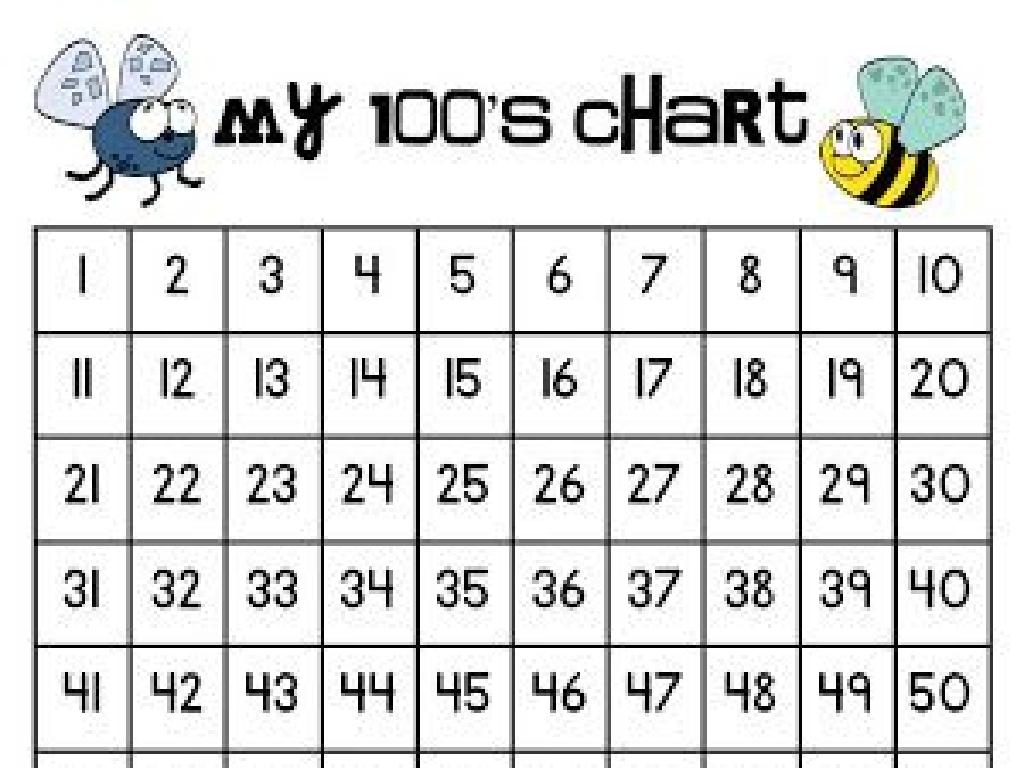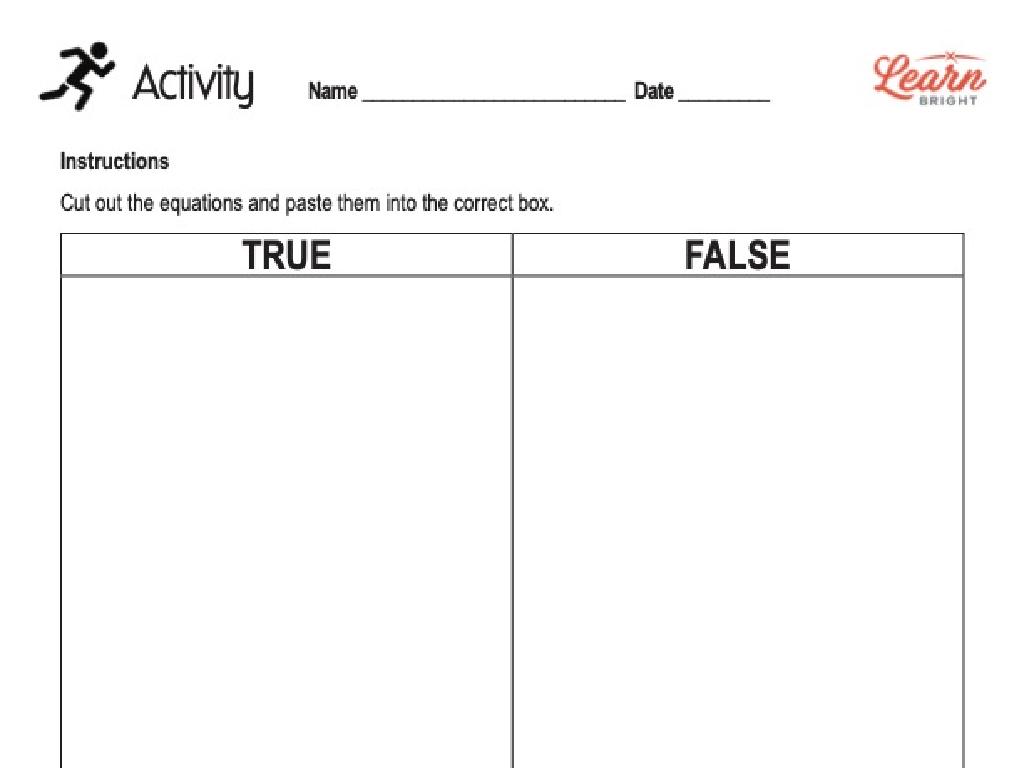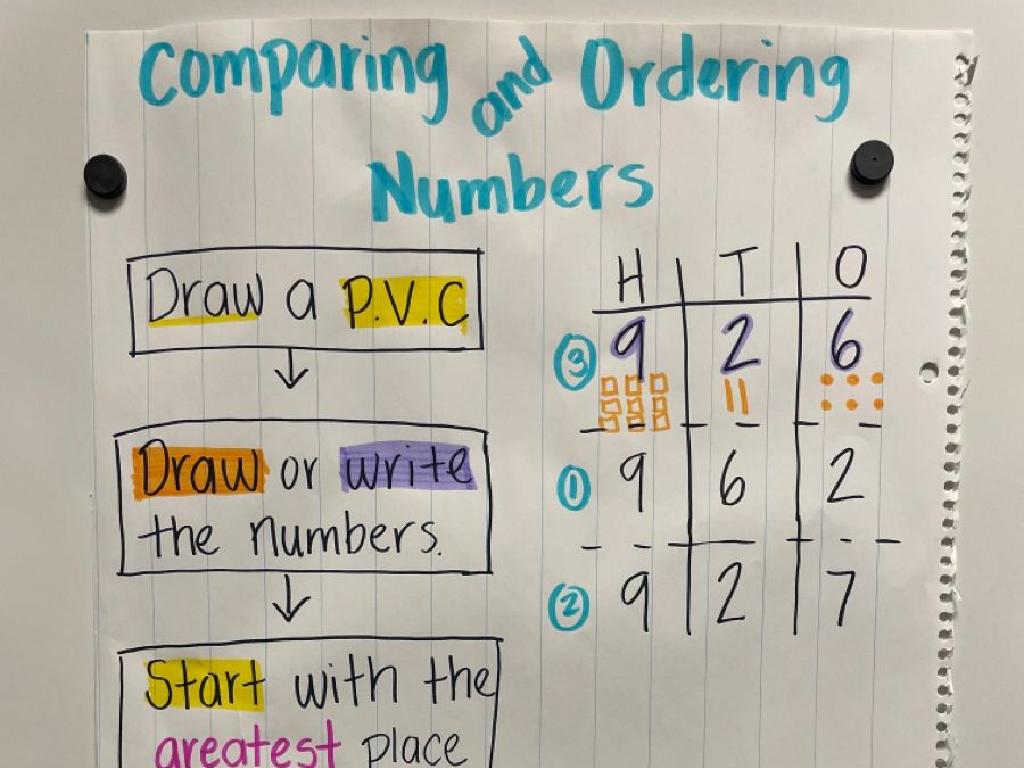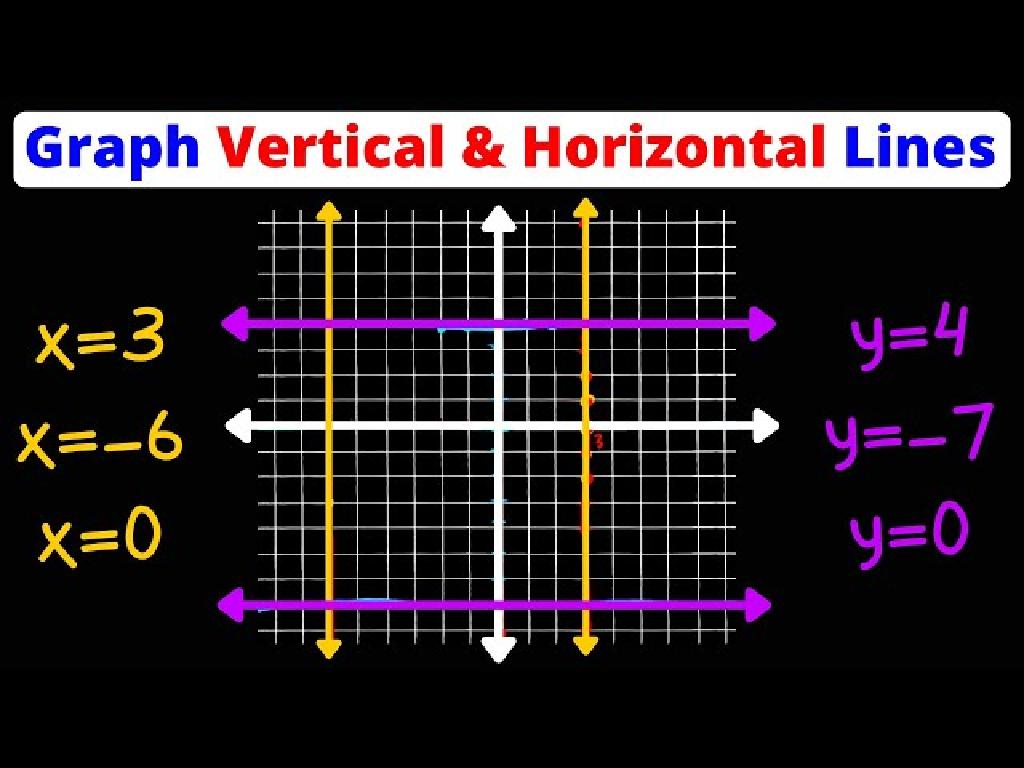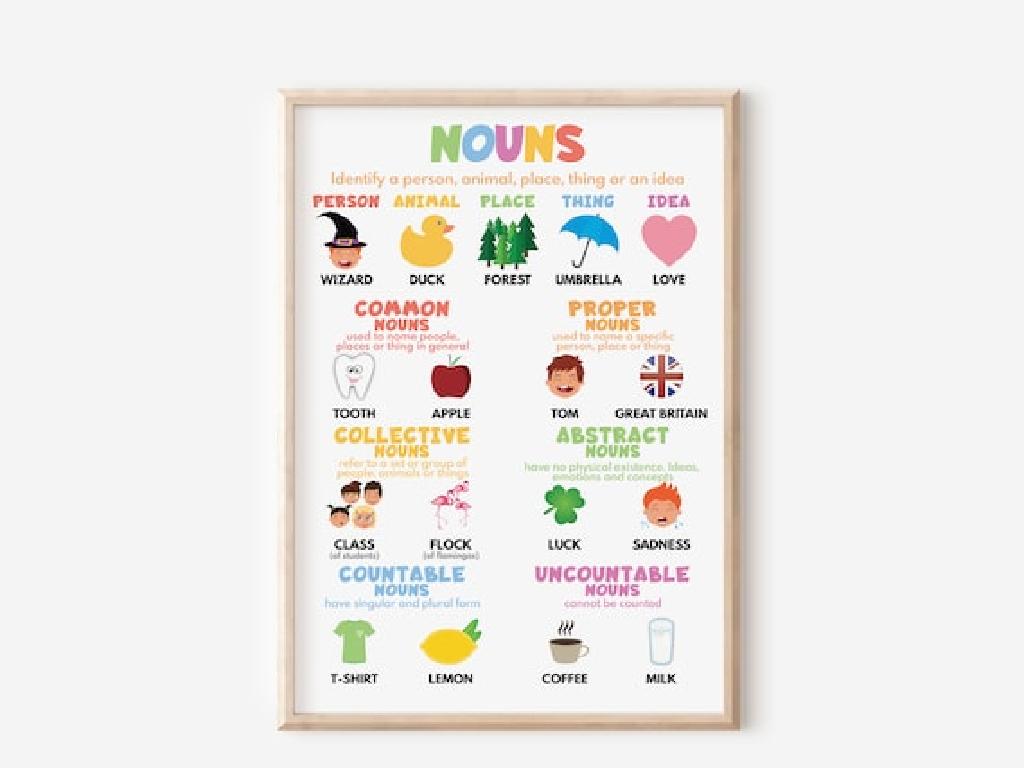Form The Perfect Verb Tenses
Subject: Language arts
Grade: Sixth grade
Topic: Verb Tense
Please LOG IN to download the presentation. Access is available to registered users only.
View More Content
Introduction to Perfect Verb Tenses
– Understanding verb tenses
– Definition of verb tenses
– Verb tenses show when an action happens: past, present, future.
– Importance in communication
– They help us express time and sequence in language.
– Examples of perfect tenses
– ‘I have eaten’ (present perfect), ‘I had eaten’ (past perfect), ‘I will have eaten’ (future perfect).
|
This slide introduces the concept of verb tenses, which are crucial for students to understand in order to communicate effectively in both writing and speaking. Verb tenses allow us to convey when an action or state of being occurs, whether in the past, present, or future. Emphasize the importance of using the correct tense to ensure clarity in communication. Provide examples of the perfect tenses, which represent completed actions in relation to another point in time, and encourage students to think of their own examples. This foundational knowledge will be built upon in subsequent lessons focusing on each specific tense.
Mastering Present Tense Verbs
– What is Present Tense?
– Present tense describes current actions or states of being.
– Regular vs. Irregular Verbs
– Regular verbs end in ‘s’ or ‘es’, irregulars vary like ‘go’ becomes ‘goes’.
– Spotting Present Tense in Sentences
– Look for actions happening now, like ‘runs’ or ‘writes’.
– Class Activity: Verb Hunt
|
This slide introduces the concept of present tense verbs to the students, explaining that it represents actions or conditions that are currently happening. Emphasize the difference between regular verbs, which typically just add an ‘s’ or ‘es’ for the third person singular, and irregular verbs, which can change in different ways. Provide clear examples for both. The activity involves students identifying verbs in the present tense within given sentences, which will help reinforce their understanding of the concept. For the activity, prepare sentences with a mix of regular and irregular verbs and have students highlight or write down the present tense verbs they find. Consider breaking the class into groups and turning it into a game for added engagement.
Mastering Past Tense in Verbs
– Understanding past tense
– Past tense verbs show actions completed in the past.
– Regular vs. irregular verbs
– Regular verbs end in ‘ed’, irregulars vary.
– Past tense verb examples
– ‘Walk’ becomes ‘walked’, ‘go’ becomes ‘went’.
– Activity: Tense transformation
– Change sentences from present to past.
|
This slide introduces the concept of the past tense and its use in English grammar. Begin by explaining that past tense verbs are used to describe actions that have already happened. Highlight the difference between regular verbs, which typically end in ‘ed’ to form the past tense, and irregular verbs, which do not follow a set pattern and must be memorized. Provide clear examples of both regular and irregular verbs. For the activity, prepare a list of sentences in the present tense that students will convert to past tense. This can include both regular and irregular verbs to practice. Possible activities: 1) Pair students to quiz each other, 2) Create a worksheet with mixed verbs, 3) Use a storytelling exercise where students continue a story using past tense verbs, 4) Have a competition to see who can correctly convert the most verbs in a given time.
Exploring Future Tense in Verbs
– What is Future Tense?
– Future tense describes actions that will happen.
– Regular vs. Irregular Verbs
– Regular verbs add ‘will’, irregulars can vary.
– Examples of Future Tense
– ‘I will walk’, ‘She will write’, ‘He will have eaten’.
– Class Activity: Crafting Future Tense
– Write 5 sentences using future tense verbs.
|
This slide introduces the concept of future tense, explaining that it’s used to describe actions that haven’t happened yet but will occur later. Highlight the difference between regular verbs, which typically just add ‘will’ or ‘shall’ before the base form of the verb, and irregular verbs, which might not follow a set pattern. Provide clear examples to illustrate both regular and irregular verbs in future tense. For the activity, instruct students to think about things they plan to do and write sentences in future tense. Offer guidance on verb choice and encourage creativity. Possible activities: writing about their next holiday, a dream they have, or plans for the weekend.
Mastering Perfect Verb Tenses
– Understanding Perfect Tenses
– Perfect tenses show completed action or time.
– ‘Completion’ in Verb Tenses
– It’s like finishing a race or a homework assignment.
– Examples of Perfect Tenses
– ‘I have eaten’, ‘She had slept’, ‘They will have arrived’.
|
This slide introduces the concept of perfect verb tenses to the students, emphasizing the idea of completion. Perfect tenses are used to indicate that an action is completed at the time of speaking or at some point in the past or future. It’s crucial to provide clear examples to illustrate the use of perfect tenses in various contexts. Encourage students to think of actions they have completed recently as a way to relate to the concept. Use visual aids or timelines to show the point of action in relation to the present moment. Instruct students to create sentences using each of the perfect tenses to reinforce their understanding.
Mastering Present Perfect Tense
– Forming Present Perfect Tense
– Combine ‘have/has’ with the past participle of the verb
– When to Use Present Perfect
– To show actions completed at an unspecified time or recently finished
– Examples of Present Perfect
– ‘I have eaten my lunch.’ shows a completed action without a specific time
– Practice with Sentences
– ‘She has visited the museum.’ indicates an experience up to now
|
The present perfect tense is formed by using ‘have’ or ‘has’ followed by the past participle of the verb. It’s used to express actions that have been completed at some point in the past without specifying when, or to talk about past experiences that affect the present. Provide students with clear examples and encourage them to create their own sentences using the present perfect tense. Emphasize the difference between simple past and present perfect, as this is a common area of confusion. Practice sentences can be turned into a game or a peer review activity to make the learning process interactive.
Mastering Past Perfect Tense
– Forming the Past Perfect Tense
– Use ‘had’ followed by the past participle of the verb, e.g., ‘had jumped’
– Understanding when to use it
– It’s used to describe an action completed before another past action
– Examples of Past Perfect Tense
– ‘She had finished her homework before dinner.’
– Practice with sentences
– Try creating sentences using the past perfect tense
|
This slide introduces the past perfect tense, which is formed by using ‘had’ plus the past participle of a verb. It’s important for students to recognize that this tense is used to talk about an action that was completed before another action in the past. Provide clear examples to illustrate this concept, such as ‘By the time he arrived, the meeting had already started.’ Encourage students to practice by writing their own sentences, ensuring they understand the formation and use of the past perfect tense. This will prepare them for more complex sentence structures and enhance their writing skills.
Mastering Future Perfect Tense
– Forming the Future Perfect Tense
– Use ‘will have’ followed by the past participle of the verb.
– Understanding When to Use It
– It’s used for actions that will be completed before a specific time in the future.
– Exploring Examples Together
– ‘By next year, I will have graduated.’
– Practice with Sentences
– We’ll write sentences predicting future accomplishments.
|
The Future Perfect Tense is formed by using ‘will have’ plus the past participle of the main verb. It’s used to discuss actions that will be completed before some point in the future. For example, ‘By the end of the week, she will have finished the project.’ In class, provide clear examples and create practice sentences together. Encourage students to think of events that are likely to happen in the future and how they would describe them using the Future Perfect Tense. This will help them grasp the concept and see its practical application.
Perfect Tense Practice Activities
– Group: Create a story with perfect tenses
– Use past, present, and future perfect tenses in a creative story.
– Individual: Rewrite a paragraph perfectly
– Focus on applying perfect tenses to improve a given paragraph.
– Review and discuss common mistakes
– We’ll look at frequent errors and learn how to avoid them.
– Q&A session to clarify doubts
|
This slide outlines two engaging activities to reinforce the concept of perfect tenses. For the group activity, divide the class into small teams and have them collaborate on a story that includes past, present, and future perfect tenses. This will help students understand the application of these tenses in a narrative context. The individual activity requires students to take a pre-written paragraph and correct the verb tenses, ensuring they are using the perfect tenses correctly. After the activities, lead a review session to go over common mistakes made with perfect tenses, and open the floor for a Q&A session to address any lingering doubts. Provide examples of common errors and their corrections to guide the discussion.
Class Activity: Perfect Tense Challenge
– Form groups for the challenge
– Complete the Perfect Tense Challenge
– Each group creates sentences in past, present, and future perfect tense
– Present sentences using perfect tenses
– Share your sentences with the class
– Discuss and give feedback
– Listen to others and think about how the sentences use perfect tense
|
This activity is designed to help students practice and understand the perfect verb tenses in a collaborative and interactive way. Divide the class into small groups and provide them with a worksheet that challenges them to form sentences using the past, present, and future perfect tenses. Each group will then present their sentences to the class. After each presentation, encourage the class to discuss the use of the perfect tense in each sentence and provide constructive feedback. Possible activities: 1) Create a story using all three perfect tenses, 2) Correct sentences that misuse perfect tenses, 3) Translate simple sentences into perfect tense, 4) Write a short paragraph using a mix of perfect tenses. This will help students to not only form the tenses correctly but also to understand their usage in context.

